Key takeaways:
- Resource waste in cannabis cultivation, such as excessive water and energy use, significantly impacts both the environment and grower profitability.
- Implementing sustainable practices like smart irrigation, renewable energy sources, and recycling materials can lead to reduced waste and cost savings.
- Sharing knowledge and advocating for sustainable practices among growers fosters a stronger community and promotes environmental stewardship.
- Future goals include integrating eco-friendly packaging and regenerative agriculture methods to enhance sustainability in the cannabis industry.
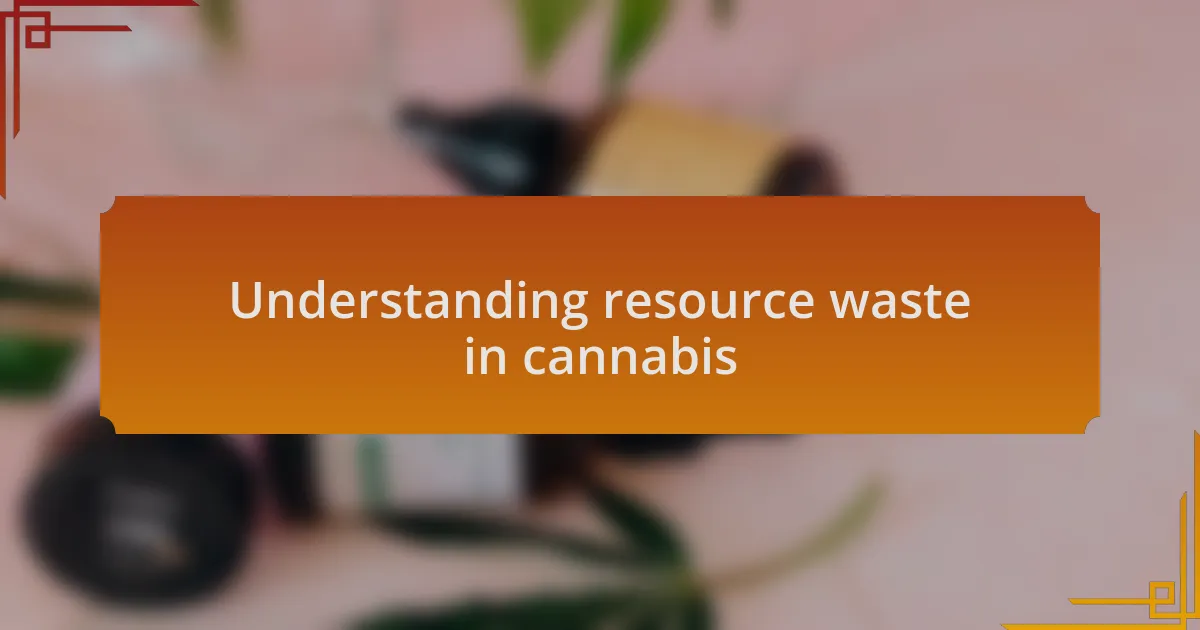
Understanding resource waste in cannabis
Resource waste in cannabis cultivation is often overlooked, yet it profoundly impacts not only the environment but also the bottom line for growers. I recall speaking with a fellow cultivator who had no idea how much water was being lost during the irrigation process. He mentioned, “It’s just a bit of excess; it doesn’t seem like a big deal.” But once I pointed out that even small waste adds up, we discussed how redirecting that water could save resources and enhance yield.
Have you ever thought about the energy consumption involved in growing cannabis indoors? I remember when I first switched to LED lights, my energy bill dropped significantly. This change not only reduced my carbon footprint but also highlighted how energy-efficient practices can lead to sustainability in the industry. Each grower has the power to reevaluate their methods and make conscious choices that reduce waste and benefit the environment.
Furthermore, it’s interesting to consider the waste generated from packaging. When I see excessive plastic and non-recyclable materials, I often wonder if the environmental impact is even part of the conversation. As consumers, we can advocate for better practices in packaging and push for a more sustainable cannabis market. This change starts with understanding our role in the ecosystem and making informed decisions.
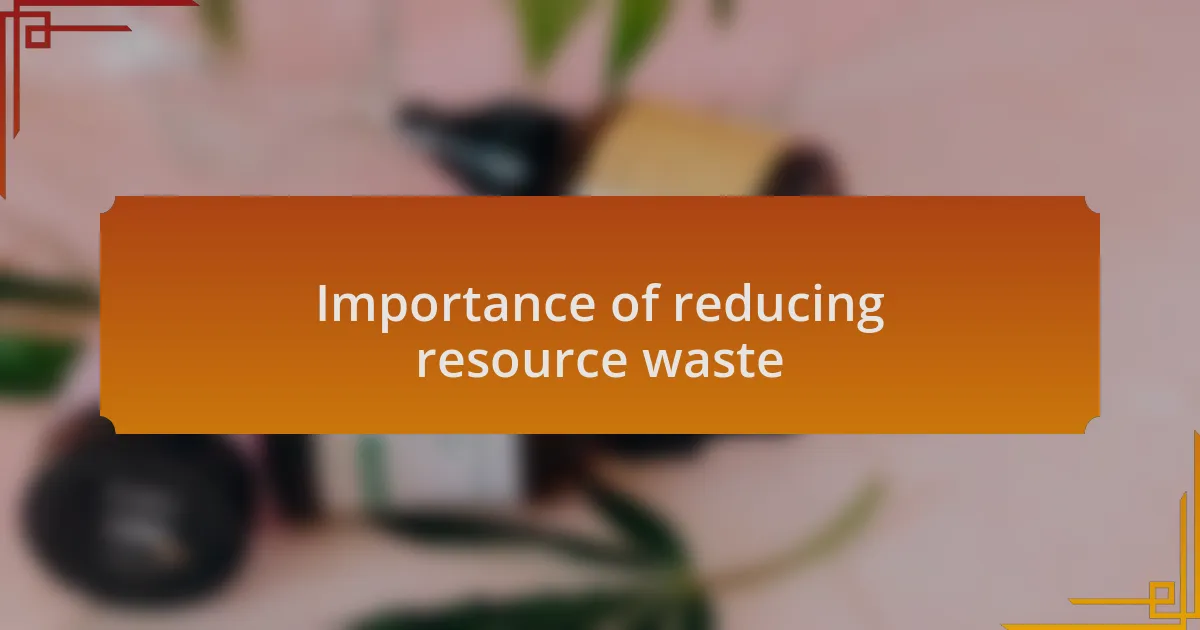
Importance of reducing resource waste
Reducing resource waste is crucial for fostering a sustainable future in the cannabis industry. I vividly recall the time I visited a local grow facility and noticed that they were using traditional methods to manage soil health, which often led to nutrient runoff. It left me wondering—how many growers overlook the potential of regenerative practices that not only minimize waste but also enrich the soil? By switching to more sustainable techniques, cultivators can enhance their product quality while actively contributing to environmental preservation.
Another aspect that stands out to me is the connection between waste reduction and cost savings. During my early days in cultivation, I was hesitant to invest in water-efficient systems, thinking the upfront costs would be prohibitive. However, once I implemented smart irrigation, I quickly realized how much more I saved in the long run. This experience taught me that being resource-conscious doesn’t just align with environmental values; it can also streamline operations and boost yields.
Moreover, the importance of reducing resource waste transcends individual operations. It’s about setting a standard for the entire community. When I see fellow growers banding together to advocate for better resource management practices, it fills me with hope. Are we not all stewards of this planet? By collectively adopting sustainable practices, we can spur a transformative movement that benefits both the industry and the Earth.
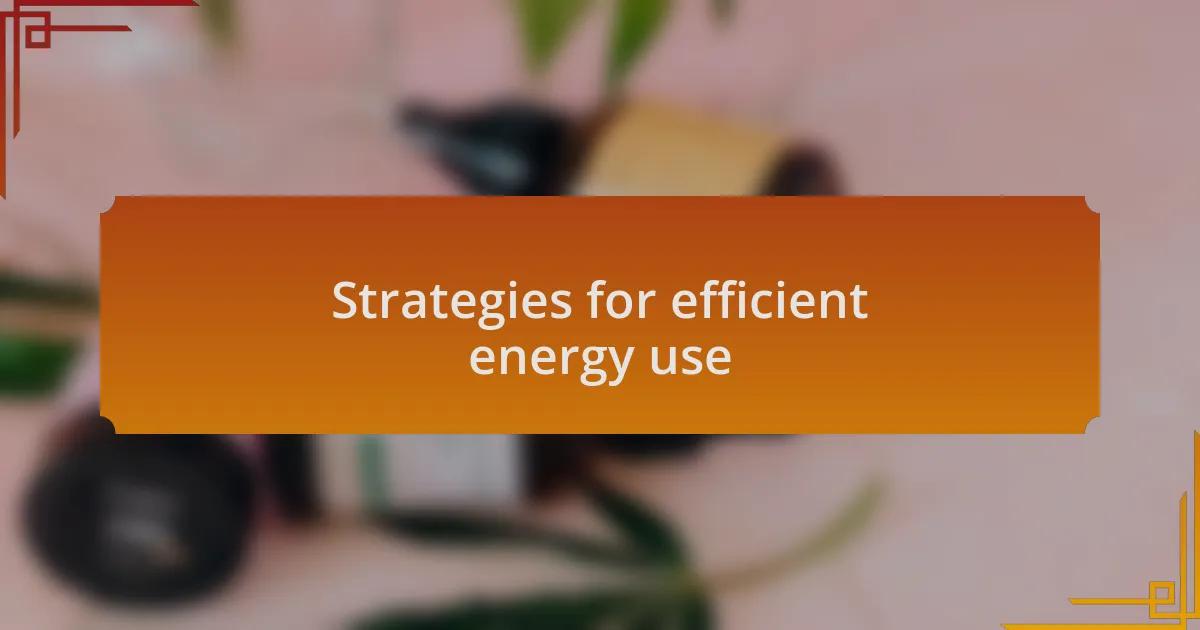
Strategies for efficient energy use
To enhance energy efficiency in cannabis cultivation, I’ve found that investing in LED lighting can make a significant difference. When I first switched my grow lights, the reduction in energy costs was eye-opening. I often think about the impact of those energy savings—what if every grower made this simple change? Collectively, it could lead to substantial reductions in carbon footprints.
One strategy that I passionately advocate is integrating smart climate control systems. I installed a programmable thermostat in my facility, and I cannot stress enough how much it transformed my energy use. By optimizing heating and cooling based on the actual needs of my plants, I not only saved energy but also created a more stable environment for growth. Have you ever considered how minor adjustments can yield major benefits?
Furthermore, considering renewable energy sources like solar power is an option every cultivator should explore. I remember the moment I saw my electricity bills drop significantly after installing solar panels. The initial investment felt daunting, but seeing those savings and knowing I was using clean energy was incredibly rewarding. Isn’t it time we embrace green energy, not just for the financial incentives but for the legacy we leave behind?
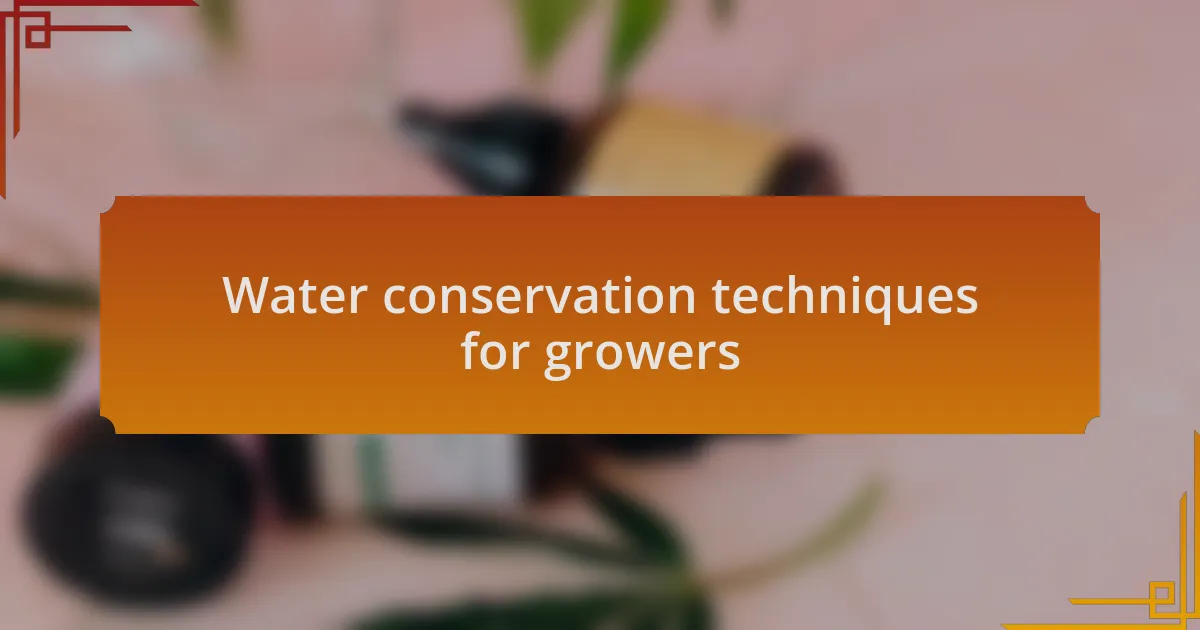
Water conservation techniques for growers
Many growers overlook the importance of efficient irrigation methods, yet the shift can be transformative. I remember the first time I switched to drip irrigation — it was like a light bulb moment. Instead of wasting water on evaporation and runoff, each drop went directly to the roots of my plants, significantly reducing overall usage. Have you ever felt the satisfaction of nurturing your plants while also being kind to the environment?
In addition to drip systems, I’ve had success with rainwater harvesting. By collecting rainwater in barrels, I not only reduced my reliance on municipal water but also created a sustainable water source for my garden. The sheer joy I felt when I first used that rainwater — knowing it was harnessed from nature — was both humbling and empowering. Imagine how much water we could all save if we all started thinking creatively like this!
Implementing soil moisture sensors is another game-changer. I was skeptical at first, but after installing them, I learned to water only when necessary. The sensors provided real-time data, allowing me to avoid overwatering—something that had been a challenge for me in the past. Have you ever considered how technology can help us be more mindful of our resources? The balance you find in your cultivation approach can lead to thriving plants and a healthier planet.
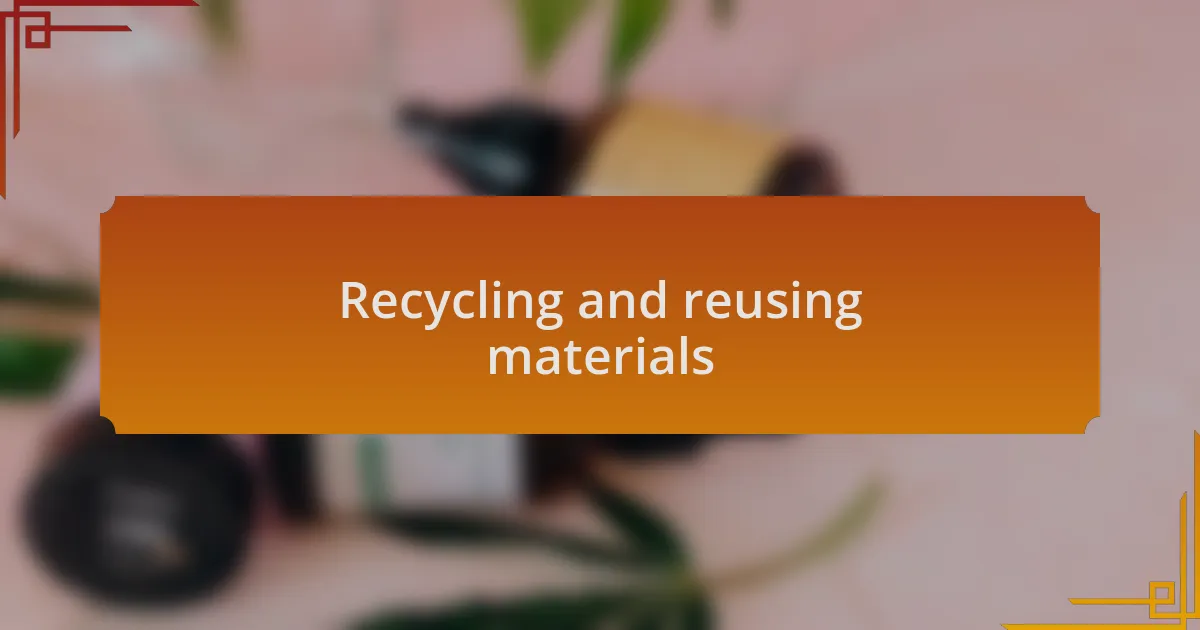
Recycling and reusing materials
Recycling and reusing materials can have a profound impact on our cultivation practices. I’ve always been surprised at how often I can repurpose items around the garden. For instance, old pots or containers can be transformed into creative seedling starters, giving those unused materials a second life while reducing waste. Have you ever looked at something considered trash and thought it might serve a new purpose?
On a recent project, I decided to turn unused pallets into raised garden beds. The experience was immensely satisfying as I saw them transform from discarded wood into functional structures that nurtured new life. Not only did this keep the pallets out of the landfill, but it also added a rustic charm to my garden space. Isn’t it incredible to think about how recycling simple materials can not only help our planet but enhance our gardening experience?
Additionally, I’ve started saving kitchen scraps for composting. Instead of tossing those leftover vegetable peels, I mix them into my compost pile, creating nutrient-rich soil for my plants. It feels rewarding to watch my waste convert into something so valuable. How often do we overlook the potential in what we consider garbage? By recycling and reusing materials, we can foster a circular economy in our gardening efforts, benefiting both our plants and the Earth.

Personal experiences in resource reduction
When I first decided to reduce resource waste, I felt overwhelmed by the challenge. One day, I stumbled upon a stack of old glass jars in my garage and thought, “Why not?” I turned them into storage containers for my dried herbs and spices. Every time I open a jar, it reminds me of my commitment to sustainability—there’s a certain joy in seeing what was stowed away now serving a purpose.
One particularly memorable instance was when I enrolled in a workshop focused on upcycling materials. I was skeptical at first, but the moment I crafted planters from plastic bottles, I was hooked. It was a revelation to realize how creative we can be when we decide to think outside the box. Have you ever felt that spark of inspiration when turning the mundane into something beautiful?
Lately, I’ve begun exploring seed saving, which has transformed my gardening strategy significantly. Collecting seeds from my favorite plants not only reduces the need for purchasing new seeds, but it also creates a deeper connection to my garden. Each seed holds a story and a potential that I’ve nurtured; it’s gratifying knowing I’ve contributed to resource reduction while preparing for future growth. Isn’t it thrilling to think that small, deliberate actions can lead to big changes in how we interact with our gardens and the environment?
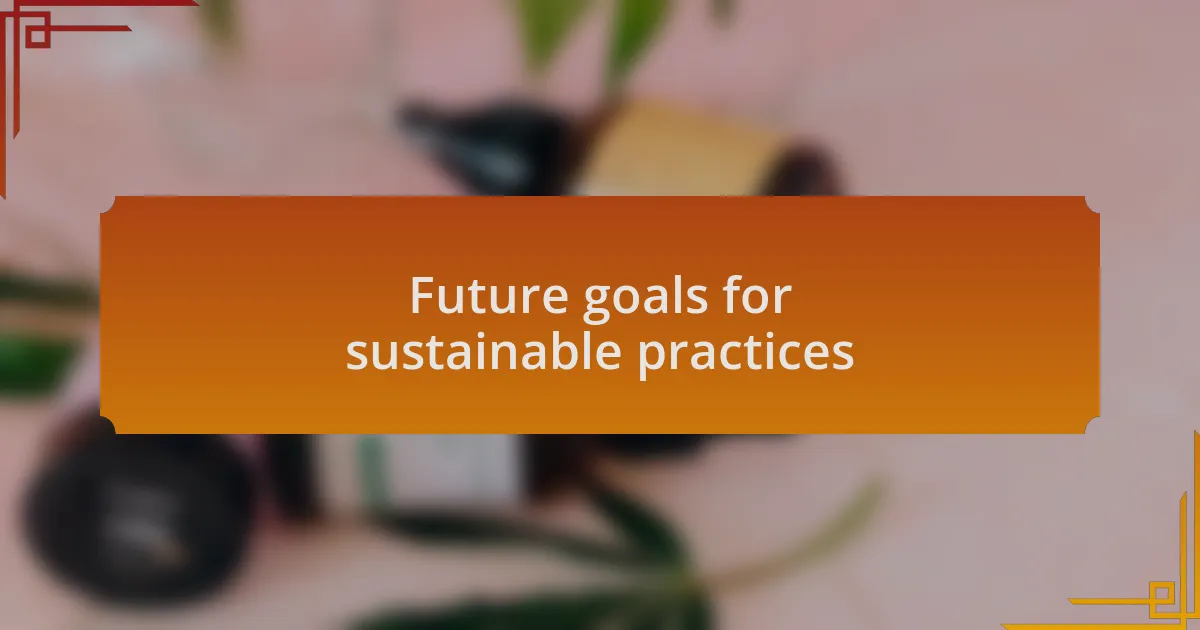
Future goals for sustainable practices
Future goals for sustainable practices
I envision a future where sustainable practices are integrated seamlessly into the cannabis industry. For instance, I recently attended an initiative that focused on developing eco-friendly packaging options. It struck me how the right choice in materials can reduce waste significantly and reflect a brand’s commitment to the planet. Wouldn’t it be fantastic if we all made informed choices that prioritize our environment?
As I delve deeper into organic farming methods, I’m increasingly motivated to advocate for regenerative agriculture within the cannabis community. I’ve experienced firsthand the positive impact of healthy soil on plant growth, and it’s clear that nurturing the earth leads to better yields. Don’t you think that fostering such relationships with our environment can revolutionize the way we cultivate cannabis?
Looking ahead, I aspire to collaborate with local growers to share knowledge on water conservation techniques. During a recent neighborhood garden meeting, I was inspired by innovative ideas shared by fellow gardeners on rainwater harvesting. It made me realize that pooling resources and wisdom can lead to a thriving ecosystem in our cannabis cultivation efforts. Are there any local practices that excite you and could be applied universally?